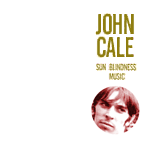 |
 |
|
|
|
| |||
 John Cale
John CaleSun Blindness Music [Table of the Elements; 2001] Rating: 8.5 When John Cale's name is dropped, any number of things might pop into your head, but chances are, it's going to be his work with the Velvet Underground. Even so, it would be shortsighted to think that his influence and importance in the last 40 years began and ended with the Velvets. Cale's rarely stopped moving in the three decades since VU disbanded, constantly shedding skins and adopting the role of shapeshifter: he's been an acclaimed solo artist (Paris 1919, Fear), a producer (Patti Smith's Horses, the Stooges, the Modern Lovers), a collaborator (Terry Riley, Nico, Brian Eno) and a soundtrack composer (Somewhere in the City). Much has been made in the avant-garde community about La Monte Young's Theater of Eternal Music (or Dream Syndicate), of which Cale was a member, along with Tony Conrad, Marian Zazeela and original VU drummer Angus Maclise. Last year saw the first release of their notorious 1965 recording, Inside the Dream Syndicate, Volume 1: Day of Niagara, a brief live representation of what the group was trying to accomplish in the mid-60s. Even with the extremely lo-fi sound quality, it's obvious that the Dream Syndicate collective was dabbling in sound worlds theretofore untouched-- minimalist drones, hypnotic chants and scraping noise barrages. Now the exhumation of several archival recordings sheds light on another dimension in Cale's chameleonic nature. Sun Blindness Music captures some of Cale's home improvisations during a period paralleling that of the Velvets' most provocative work (1965-68). It's the first disc of three in a series of unearthed Cale compositions from Table of the Elements (all released under the heading New York in the 1960s), documenting his solo experiments and collaborations with other members of New York's avant-garde underground. Collecting dust in Tony Conrad's possession for years, these tapes were probably all but forgotten by everyone excepting possibly Conrad and Cale. Some will undoubtedly argue they should have stayed that way. The record is comprised of three tracks, two of which are centered on Cale's experiments with a Vox Continental organ. Its title track is an incredibly extended improvisation consisting of just Cale and the Vox. Without any real structure, Cale fools around with minimalist sound dimensions. He jams keys into place, locks into a series of drones, mounts pressure on the organ, clusters notes and creates a dissonant wash of noise. At times, Cale occupies himself with an escalating build of resonant, booming drones; other times, drones disintegrate into silence as Cale fumbles for another cluster of keys to wedge in place. Unlike what most people perceive as minimalism, this opening track is propelled by momentous force, dynamism and sweat. It can be both mesmerizing and disconcerting, often within a brief time span. Regardless, at 42 minutes, it's an endurance test no matter who's listening. However, for those willing to provide full attention and look past the somewhat lo-fi sound, it can be a meditative piece of work filled with vibrating textures and radiating intensity. Beyond the difficult and lengthy nature of "Sun Blindness Music," the remainder of the album is slightly more accessible. "Summer Heat" is a raucous guitar-driven track where everything is awash with massive distortion. The final result sounds more like pounding percussion than guitar strumming. Predating stuff like Glenn Branca's guitar symphonies, Arnold Dreyblatt's "sound of one string" experiments, and even partner Lou Reed's Metal Machine Music by several years, this track is a murky, percussive sludgefest. Thundering on for about 11 minutes, it's an early and brilliant attempt at merging the sounds of rock with minimalism. Sadly, the poor sound quality of the tapes rears its head toward the song's end when the distorted guitars are unceremoniously stopped midstream by tape warble, segueing into the third and final track, "The Second Fortress." Though the only instrument credited on this last song is "electronic sounds," it's actually Cale manipulating his Vox again, this time into a series of high-pitched drones. The sound here borders on the popular conception of minimalist music, with repetitious ambient textures. Gone are the obvious crammed-into-place keys and pressured sustain of "Sun Blindness Music." They've been replaced with the musician coaxing a shimmering series of drones out of his organ. The pulsating texture is still present, but the pace gives the impression of gliding along into soundscape territory as opposed to the fevered swells of the title track. For musical archaeologists, this disc is only the beginning of an archival dig. With two more discs to be released in the coming months, you'd think Table of the Elements had cornered the market on these historic minimalist documents. And they pretty much have. Along with the aforementioned Day of Niagara, there's also the scraping, extreme drones of Tony Conrad's Four Violins box set. Siltbreeze tried their hand at it, as well, and released a couple of highly recommended Angus Maclise recordings, The Invasion of Thunderbolt Pagoda and Brain Damage in Oklahoma City. Meanwhile, La Monte Young is still sitting on a treasure chest of Theater of Eternal Music recordings, though the likelihood of them being released in the near future is minimal. Taken with everything else, the new Cale disc rests perfectly amongst the other historical documents. And although it stands well on its own, it would be a mistake to treat it as anything other than a vital component of the early minimalist and Dream Syndicate canons. Sun Blindness Music is a portrait of an artist engaged in the maturing process, actively seeking out new sounds while simultaneously breaking down barriers of the old. It's not always successful, but taken in conjunction with his VU work during the same period, it's clear that Cale aggressively and enthusiastically pursued new sound territories. -Luke Buckman, October 25th, 2001
|
|||

